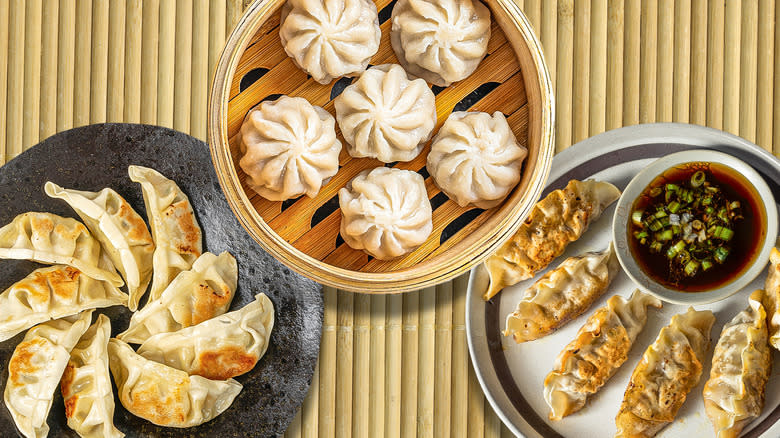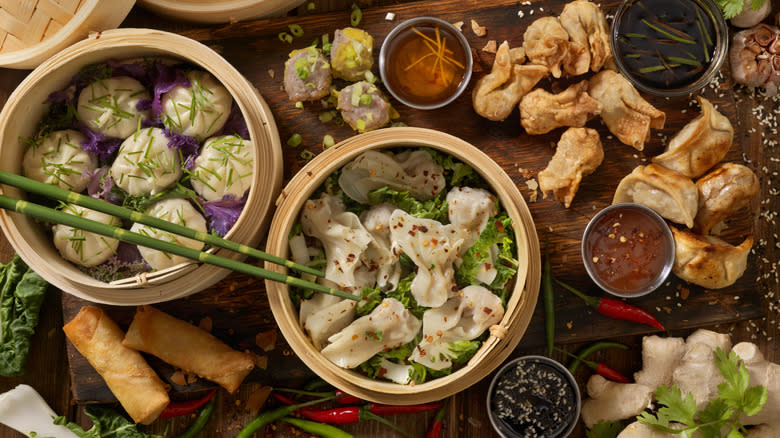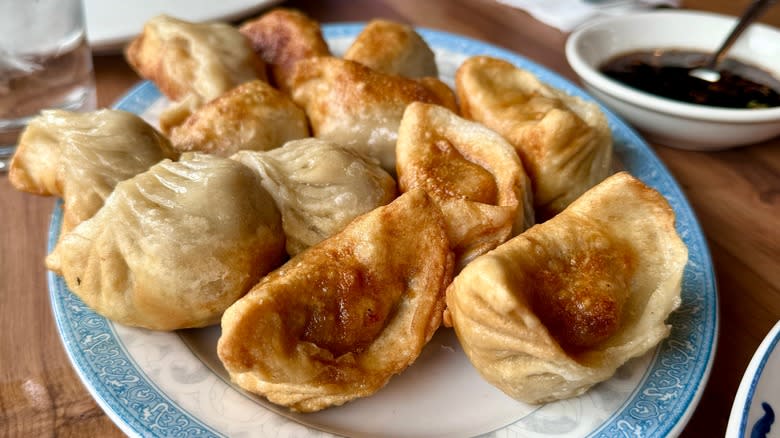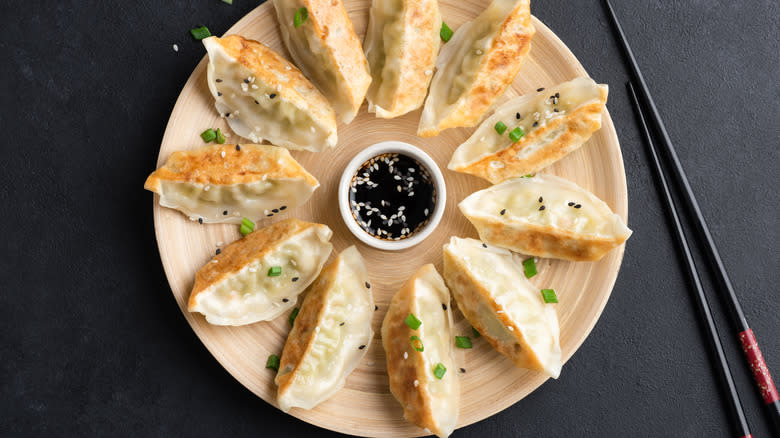What's The Difference Between Gyoza, Dumplings, And Potstickers?

There's a good reason nearly every culture around the world has a version of dough wrapped around a tasty filling. Not only is it convenient and fun to consume these tasty morsels, but it also allows a small quantity of more expensive ingredients to be extended into a more substantial meal. When it comes to Asian-style dumplings, you'll see many ways to list them on a menu -- from dumplings to potstickers to gyoza. While they're all delicious, the various names can lead to some confusion.
A culinary tour of dumplings will reveal soft, hand-made wheat dough wrappers as well as a nearly endless variety of styles of premade rounds and squares, all made for enclosing a filling. A stickler for detail might insist that a potsticker has one type of casing and the closely related gyoza has another. But on close inspection, you'll see overlap in how these two cousin dumplings are produced and in their cooking techniques. While they're all popular restaurant dishes, reading this might give you the inspiration to try making your own batch when the craving for dumplings hits.
Read more: Restaurant Foods That Always Taste Better Than What You Make At Home
What Are Dumplings?

It's safe to say that the term dumpling is the overarching category name for unleavened dough encasing a filling, which is then cooked. Recipes for the filled food parcels have been found in ancient Roman cookbooks, and Chinese legend traces the origin of jiaozi dumplings there back 1,800 years. Archeologists have found dumplings in gravesites in China dating back to the year 200, which look pretty similar to something you'd see today. In China, the most popular dumpling variety is still jiaozi, which are basically steamed gyoza, filled with pork and cabbage, and served with a simple soy-based dipping sauce.
As dumpling recipes traveled from country to country with the movement of people through time, the fillings and wrapper style were adapted by new cooks to suit local ingredients and tastes. And with movement, the names changed, too, sometimes on purpose and sometimes due to pronunciation differences.
Dumplings are so diverse because they've been around for so long, with recipes passed down through dozens of generations. You'll find them steamed, boiled, pan-fried, deep-fried, or prepared with a combination of cooking techniques. Their fillings are mostly savory, packed with seasoned meat or vegetables, but there are sweet varieties, too.
What Are Potstickers?

The term potsticker describes a particular cooking technique for traditional Asian dumplings. A plump, cooked dumpling is allowed to brown in the wok or skillet to gain some crunch and a golden-brown, delicious crust — hopefully without sticking to the pot! This kitchen magic is typically performed on a thicker-skinned, pleat-folded dumpling that won't be too flimsy to survive the extra cooking steps.
Legend says the origin of browning the dumplings was a happy accident that occurred when a cook forgot to check on his steaming dumplings in the wok. The water evaporated, and the dry wok ended up toasting the dough. We don't recommend neglecting your dumplings. A better, more reliable outcome results from browning the potstickers' bottoms in a nonstick pan for a few minutes and then adding water to steam them. Potstickers usually arrive with a dipping sauce made of soy sauce brightened with a bit of black vinegar, although there are many innovations in how they're served, including the viral wet-wet sauce spiked with chili oil that makes a flavorful accompaniment.
If you're keen to try making them at home, you could start with our homemade veggie potstickers recipe.
What Are Gyoza?

If you've ordered gyoza at your local Japanese restaurant, you've probably noticed they are typically pretty similar to potstickers. Chinese-style browned dumplings were brought to Japan by travelers and returning soldiers who enjoyed them. The pronunciation of the Chinese word for dumpling, jiaozi, became gyoza in Japanese, thus the two names for very similar foods.
Homemade versions are most often prepared with store-bought gyoza wrappers, which are quite thin. For that reason, the filling needs to be very finely chopped so it doesn't poke through, and they need to be cooked carefully so that the casing doesn't break. There are commonly three different styles of cooked gyoza: The golden, crisp-bottomed potsticker style, which is the most widely seen preparation; deep fried gyoza, the second-most common, are the same basic dumplings but fully crunchy; and boiled gyoza, which are less frequently seen and sometimes served in soup broth. All three styles are usually served with a soy sauce-based dipping sauce to balance the rich filling flavors.
Read the original article on Tasting Table

